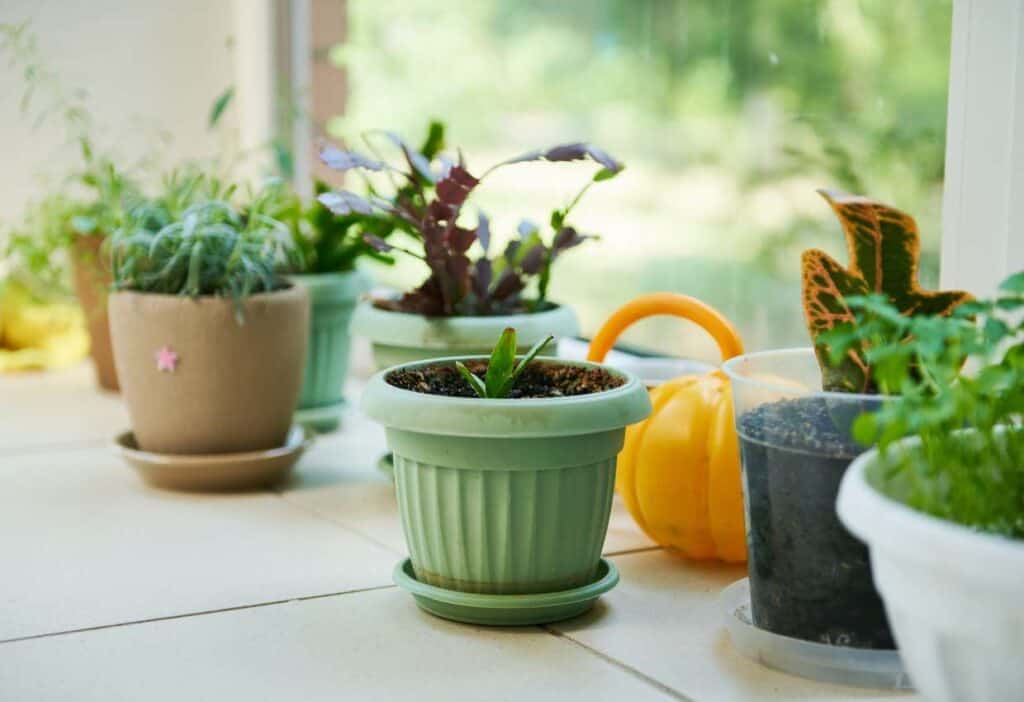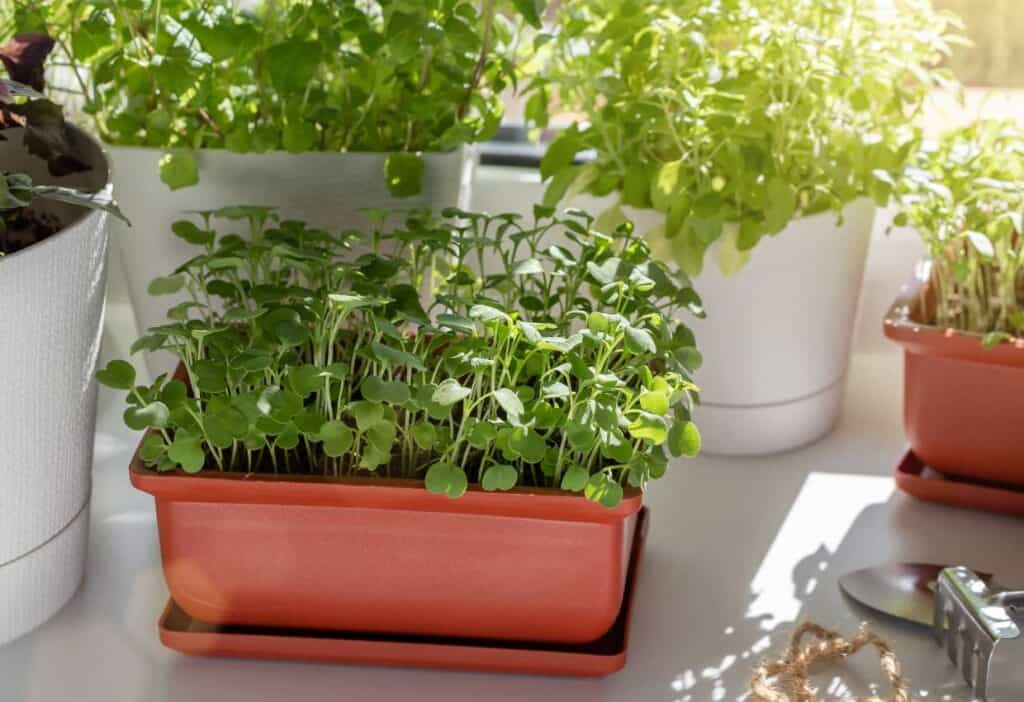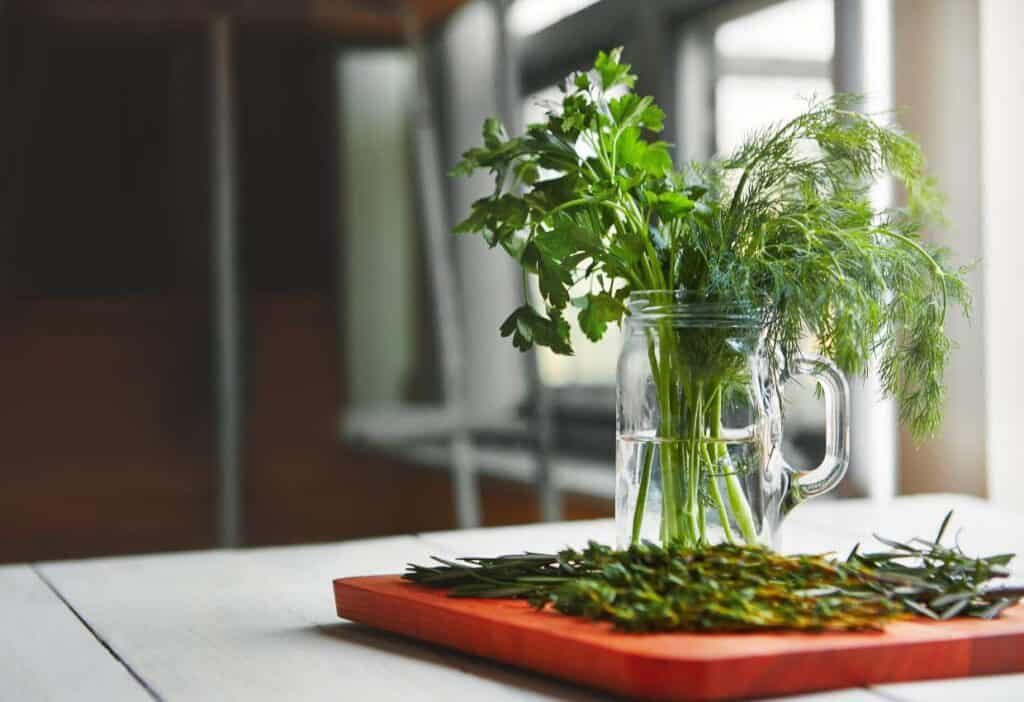Whether you’re looking to add a punch of flavor to your cooking or just want a bit of greenery around, starting an herb garden is simpler than you think. Learn about the five easiest herbs to grow indoors, making fresh flavors accessible from your windowsill.

This post may contain affiliate link(s). As an Amazon Associate, I earn from qualifying purchases. See Disclosures.
Ever thought about growing your own herbs but worried you might not have the right space or skills? Good news. Some herbs practically grow themselves, especially indoors — even if you’re a beginner gardener.
5 easiest herbs to grow indoors
Growing your fresh herbs indoors is a great way to add flavor to your cooking and save money on groceries. But which herbs are the easiest to grow inside? Here are five of the best options for an indoor herb garden.
Basil
One of the easiest herbs to grow indoors, basil thrives in warm temperatures and bright, indirect light. It grows quickly and can be harvested frequently , and if your looking to grow multiple kinds of herbs, check out these companion herbs for basil. This versatile herb is used in everything from pesto to pasta sauce.
Chives
Chives are a low-maintenance herb that grows well indoors. They prefer cool conditions and need 4 to 6 hours of bright light daily. Fresh chives add a mild, onion-like flavor to salads, pasta dishes, stir-fries and soups or stews.
Mint
Mint is a tough herb that thrives indoors and grows quickly. Plant it alone, or it will overtake your other indoor herbs. Compared to other herbs, it can tolerate lower light conditions, which makes it ideal for winter gardening indoors.
Use mint to make herbal tea or add it to desserts and salads. Your favorite variety of mint also makes a pretty garnish for iced tea and lemonade.
Parsley
Grow parsley indoors on your kitchen window sill to soak up that sun. Parsley is rich in vitamins and antioxidants and tastes great in your favorite baked fish recipe, salad or stew. Harvest the outer leaves first to encourage continued growth.
Rosemary
Grow rosemary indoors in an area with plenty of sunlight and in a pot with well-drained soil. Water it only when dry.
Use rosemary’s flavorful leaves in Italian dishes and infused olive oils. Preserve excess by drying, freezing chopped rosemary in trays with oil or water or refrigerating fresh sprigs wrapped in damp towels inside a bag for up to two weeks.
“I keep a dish garden of Mediterranean herbs — thyme, oregano, rosemary and sage — in my kitchen year-round. They are super low-maintenance as long as they have enough light, which is why I have a grow light in the fixture just above them. They also seem to do better when you forget to water them for a bit.”
— Sage Scott, Sage Alpha Gal
Tips for growing herbs indoors

Now that you know some of the easiest herbs to grow indoors, use these tips to get started.
Provide adequate light
Most herbs require at least 6 hours of direct sunlight per day. A south-facing window is ideal. If you don’t have a sunny window, consider using grow lights to provide the light your herbs need to thrive indoors.
Use well-draining soil
Herbs grown indoors need well-draining soil to prevent the roots from sitting in water and rotting. Use a potting mix designed for indoor plants, or make your mix using equal parts peat moss, vermiculite and perlite. Make sure your pots have drainage holes.
Water regularly
Water your herbs when the top inch of soil feels dry. Avoid overwatering, which can lead to root rot. Pour enough water until it flows from the drainage holes, then empty the saucer to prevent the plant from sitting in standing water. Herbs need less water in winter when growth slows.
Fertilize occasionally
Fertilize indoor herbs every two to four weeks during the growing season using a half-strength solution of liquid fertilizer, homemade fertilizer or natural plant food. Avoid over-fertilizing, which can cause herbs to produce lots of flavorless foliage.
Harvest frequently
Regularly harvesting your herbs encourages the plant to produce new growth and prevents them from getting too woody. Harvest up to one-third of the plant at a time.
Pinching off the growing tips also helps promote bushier, compact growth. You can even replant your herb snippets in your outdoor potager garden.
Storing and using fresh herbs

Indoor herb gardening is a fun DIY gardening project for the whole family. But when the posts start to overflow, you’ll need to know how to store and use them properly.
Storing herbs in the refrigerator
To store fresh herbs, wrap them loosely in a damp paper towel and place them in a resealable plastic bag in the refrigerator. Most herbs will last up to a week stored this way. Avoid washing until ready to use to prevent premature spoilage.
Using fresh herbs in recipes
Add fresh herbs to dishes at the end of cooking for the brightest flavor. Chop or tear herbs just before using. Dried herbs are more potent than fresh, so use about one-third the amount in recipes. Experiment with different herb combinations in your favorite healthy recipes.
Troubleshooting common issues
Even with the easiest herbs to grow indoors, you may encounter some issues. Here are some of the most common ones.
Dealing with pests
When you grow herbs indoors, watch out for aphids, spider mites, mealybugs and whiteflies. Regularly inspect plants and separate any infested herbs.
Use insecticidal soap or neem oil to control pests. You can also try rinsing them off with a strong spray of water.
Reviving wilted herbs
If your herbs are wilting, check the soil moisture. If the soil is dry, water thoroughly.
Trim off any dead or damaged foliage. If the plant is not getting enough light, move it to a brighter location. Wilting can also be a sign of root rot from overwatering.
Preventing mold growth
Mold on the soil surface is usually harmless but indicates the soil is too moist. Avoid overwatering, and make sure the pot has good drainage.
Remove any moldy leaves or soil. Improve air circulation around the plant. Using a gentle fan can help.
With these tips, you’ll soon enjoy a thriving indoor herb garden year-round. Whether you choose basil, chives, mint, parsley, rosemary or any of the other easiest herbs to grow indoors, you’ll enjoy the convenience and flavor of homegrown herbs in your cooking.
Sarita Harbour is a homeschooling, homesteading mom and a long-time business and finance writer. She created An Off Grid Life to help people become more self-reliant. Sarita and her family live off the grid in Canada’s Northwest Territories.